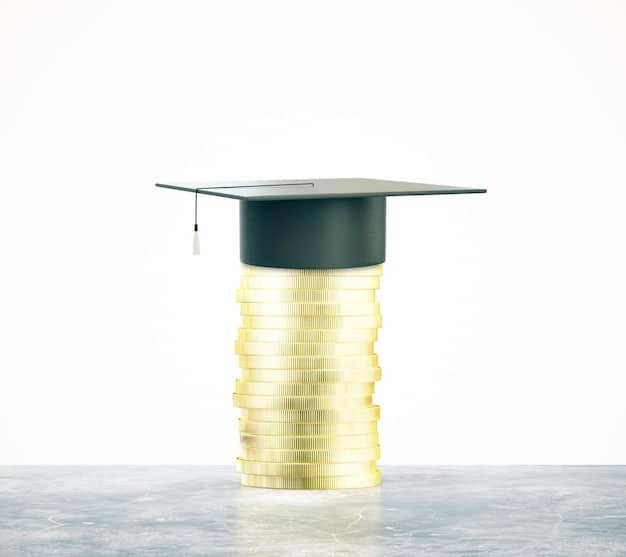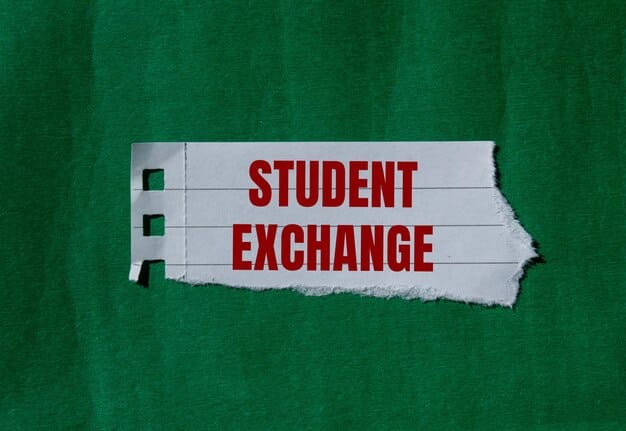Evaluating Federal Student Loan Forgiveness Claims in 2025: A Fact Check

Evaluating the accuracy of claims regarding changes to federal student loan forgiveness programs in 2025 involves scrutinizing proposed policy adjustments, eligibility criteria, and potential impacts on borrowers, requiring diligent verification against official sources and expert analysis.
Navigating the landscape of federal student loan forgiveness programs can be confusing, especially with frequent policy changes and evolving eligibility requirements. As we approach 2025, it’s crucial to ensure that claims regarding changes to federal student loan forgiveness programs in 2025 are accurate and reliable.
Understanding Federal Student Loan Forgiveness Programs
Federal student loan forgiveness programs are designed to help borrowers manage their debt by offering options to have a portion or all of their loans forgiven under specific conditions. Several programs exist, each with its own set of rules and eligibility criteria. Understanding these programs is essential to assess the accuracy of any claims regarding changes in 2025.
Key Federal Student Loan Forgiveness Programs
The landscape of federal student loan forgiveness programs is diverse, comprising several key initiatives. Each program is designed to assist borrowers under specific circumstances, providing a pathway to alleviate their student loan debt.
- Public Service Loan Forgiveness (PSLF): This program forgives the remaining balance on Direct Loans after 120 qualifying monthly payments made under a qualifying repayment plan while working full-time for a qualifying employer.
- Income-Driven Repayment (IDR) Forgiveness: These plans, such as Income-Based Repayment (IBR), Pay As You Earn (PAYE), and Saving on a Valuable Education (SAVE), offer forgiveness after 20 or 25 years of qualifying payments, depending on the plan.
- Teacher Loan Forgiveness: Eligible teachers who serve for five consecutive years in a low-income school may qualify for forgiveness of up to $17,500 on their Direct Loans or FFEL loans.
These programs play a crucial role in helping borrowers manage their student loan debt. Understanding the specifics of each program is essential when evaluating claims about potential changes in 2025.
In conclusion, understanding the intricacies of each program is crucial for both borrowers and stakeholders to accurately evaluate any proposed changes and their potential impact.
Claims Surrounding Changes in 2025
As we approach 2025, numerous claims are circulating about potential changes to federal student loan forgiveness programs. These claims range from adjustments to eligibility criteria to modifications in the amounts forgiven. It’s vital to critically assess these claims, discerning fact from speculation.

Common Claims and Misconceptions
Several common claims and misconceptions are often associated with changes to federal student loan forgiveness programs. Understanding these narratives is crucial for accurate evaluation.
- Eligibility Expansion: Claims suggesting that eligibility for forgiveness programs will significantly expand in 2025, potentially including more borrowers with diverse employment backgrounds.
- Forgiveness Amount Increases: Assertions that the maximum forgiveness amounts will increase, providing more substantial relief to borrowers with high debt balances.
- Program Simplification: Suggestions that the application and qualification processes will be simplified, making it easier for borrowers to access forgiveness benefits.
It is important to approach these claims with caution and verify them against official sources.
In summary, claims surrounding changes in 2025 should be carefully evaluated. Verifying these claims ensures that borrowers are well-informed and can make sound decisions about their student loans.
Evaluating Claim Accuracy: A Methodical Approach
Evaluating the accuracy of claims requires a systematic approach that involves consulting reliable sources, understanding policy details, and staying informed about official announcements. This ensures a clear understanding of the actual changes and their implications. By following these steps, borrowers can make informed decisions about their student loans.
Checking Official Government Sources
Official government sources, such as the Department of Education’s website, are primary resources for verifying information about federal student loan forgiveness programs. These sources provide the most accurate and up-to-date details.
- Department of Education Website: Regularly check the Department of Education’s website for official announcements, policy updates, and detailed program information.
- Federal Student Aid Resources: Utilize the Federal Student Aid website for comprehensive resources, including eligibility criteria, application processes, and repayment options.
- Government Accountability Office (GAO) Reports: Review GAO reports for independent analyses and audits of federal student loan programs, providing insights into their effectiveness and potential areas for improvement.
Leveraging these resources ensures access to reliable information and a clear understanding of the programs.
In conclusion, consulting official government sources is an essential step in evaluating the accuracy of claims about federal student loan forgiveness programs. Keeping track of official announcements can help borrowers and stakeholders stay informed and avoid misinformation.
Expert Opinions and Policy Analysis
In addition to official sources, consulting expert opinions and policy analysis can provide deeper insights into the potential changes to federal student loan forgiveness programs. Experts often offer valuable perspectives on the implications of policy adjustments.

Seeking Advice from Financial Advisors and Policy Analysts
Financial advisors specializing in student loans and education policy analysts can provide informed opinions and detailed analysis of the potential changes to federal student loan forgiveness programs.
Financial advisors can help borrowers understand their options and make informed decisions based on their individual financial situations. Policy analysts offer insights into the broader implications of policy changes.
In conclusion, seeking advice from experts and reviewing policy analysis can help borrowers and stakeholders gain a more comprehensive understanding of the potential changes to federal student loan forgiveness programs.
Historical Context and Program Evolution
To accurately evaluate claims regarding changes to federal student loan forgiveness programs in 2025, it’s helpful to understand the historical context and evolution of these programs. This context provides a foundation for understanding the current state of the programs and the direction of potential changes.
Key Milestones in Student Loan Forgiveness
Understanding the key milestones in the history of student loan forgiveness programs can provide context for evaluating current claims and future changes.
- Creation of Income-Driven Repayment Plans: The introduction of IDR plans like IBR and PAYE marked a shift towards more flexible repayment options tied to borrowers’ income.
- Establishment of Public Service Loan Forgiveness (PSLF): The creation of PSLF aimed to incentivize careers in public service by offering loan forgiveness after a set period of qualifying employment.
- Temporary Relief Measures During Crises: Various temporary relief measures, such as payment pauses and interest waivers, have been implemented during economic crises to provide immediate relief to borrowers.
These milestones reflect ongoing efforts to improve and refine student loan forgiveness programs.
In conclusion, understanding the historical context of student loan forgiveness programs provides valuable insights for evaluating claims and assessing the potential impact of future changes.
Staying Informed and Avoiding Misinformation
Staying informed about federal student loan forgiveness programs is crucial for borrowers who wish to make informed decisions and manage their student loans effectively. This involves continuously educating oneself on any new developments and avoiding misinformation.
Tips for Staying Updated
Staying updated on federal student loan forgiveness programs requires actively seeking reliable information and avoiding misinformation. Here are some practical tips.
- Subscribe to Official Newsletters: Sign up for newsletters from the Department of Education and Federal Student Aid to receive updates directly in your inbox.
- Follow Reputable News Outlets: Monitor news outlets known for their accurate reporting on education and financial policy.
- Engage with Trusted Online Communities: Participate in online forums and communities where borrowers share information and experiences related to student loans, but always verify the information shared.
Proactive engagement ensures access to accurate information.
In conclusion, staying informed and avoiding misinformation is key to effectively managing student loans. By actively seeking reliable sources and engaging with trusted communities, borrowers can make informed decisions and navigate the complexities of federal student loan forgiveness programs.
| Key Point | Brief Description |
|---|---|
| ✅ PSLF Requirements | Confirm if working for a qualifying employer for PSLF. |
| 💰 IDR Plans | Verify updated terms for income-driven repayment plans like SAVE. |
| 📰 Official Sources | Always check the Department of Education’s website directly. |
| 🧑💼 Expert Advice | Consult financial advisors to understand policy impacts. |
Frequently Asked Questions
The primary programs include Public Service Loan Forgiveness (PSLF), Income-Driven Repayment (IDR) forgiveness, and Teacher Loan Forgiveness. Each has specific eligibility requirements.
Check official government sources like the Department of Education’s website and consult financial advisors for expert opinions on potential impacts.
PSLF forgives the remaining balance on Direct Loans after 120 qualifying monthly payments made while working full-time for a qualifying employer.
Yes, IDR plans like IBR, PAYE, and SAVE offer forgiveness after 20 or 25 years of qualifying payments, depending on the specific plan.
The Department of Education’s website and the Federal Student Aid website are reliable sources for official updates and detailed program information and policy changes.
Conclusion
Evaluating claims regarding changes to federal student loan forgiveness programs in 2025 requires a proactive approach, leveraging official sources, expert opinions, and historical context. By staying informed and employing critical evaluation skills, borrowers can effectively navigate the complexities of student loan management and make informed decisions.





